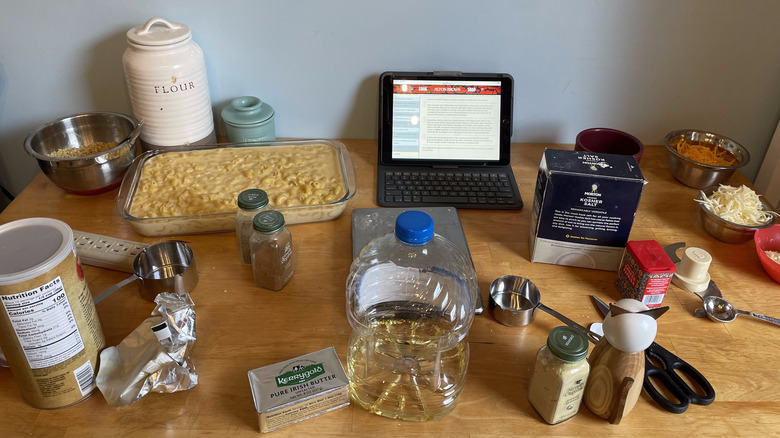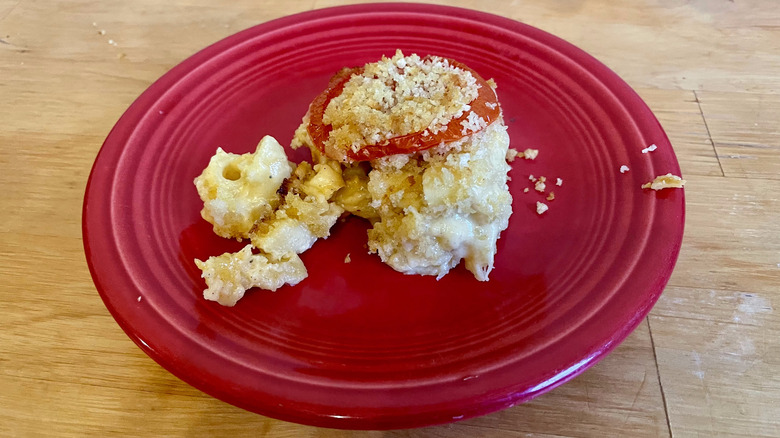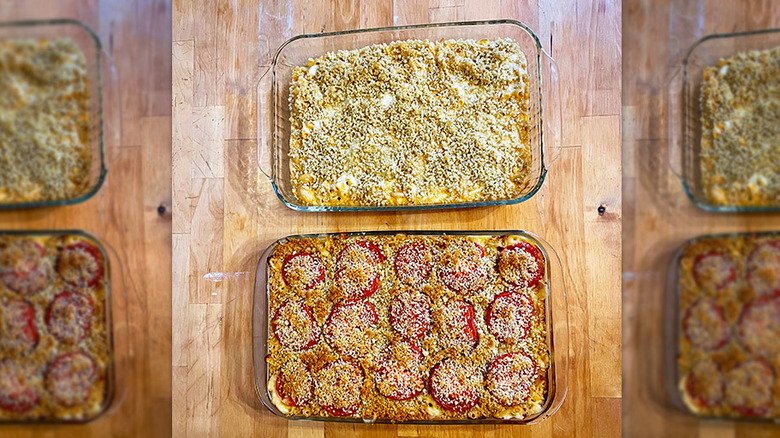We Compared Alton Brown's Mac And Cheese Recipe To Ina Garten's To See Which Chef's Was The Best
Macaroni and cheese is one of the best and most hotly contested dishes to ever hit the dinner table. If you have been tasked with bringing mac and cheese to a dinner party, then you likely already know you can't make just any mac and cheese if you want to impress the other guests. A look at the many mac and cheese recipes out there, even from professional chefs, can start to seem daunting.
But why waste time testing recipes when you could simply read on? We pitted two of the most popular celebrity chef macaroni and cheese recipes against each other to find out which one reigns supreme. To keep our assessment fair, we chose two baked mac and cheese recipes from big-name chefs.
Our two contestants are Alton Brown and Ina Garten, both longtime celebrity chefs known for their delicious creations. While there are variations of each recipe floating around, we used the original recipes currently available on each chef's official website. Not only did we consider the final result, but we also took into account every aspect of creating these delicious, gooey dishes. At the end of the day, only one can be the winner.
Alton Brown's macaroni and cheese
Our first contestant is Alton Brown. Brown is most prominently known for his television show "Good Eats," which first aired in 1999. Brown knows his stuff, as his shows, books, and other work offer insight into not only how to cook certain foods but also the science and chemistry behind them. Brown also has a few James Beard awards for good measure.
Brown's mac and cheese is a classic, unadulterated version of the dish. No add-ins like meat or vegetable matter find their way into the dish here. Brown's recipe was first seen in Season 5 of "Good Eats." In the episode, "For Whom the Cheese Melts 2," Brown credits Kraft for popularizing the dish with the American public, while oh-so-humbly stating that his version is superior. You can see the influence of the childhood favorite of boxed mac and cheese here via the inclusion of paprika, which enhances the orange hue of the dish.
Ina Garten's macaroni and cheese
Ina Garten has had a fascinating and successful career, including an early stint in the White House Office of Management and Budget. Garten's first foray into the professional food scene came when she impulsively bought a specialty food store called the Barefoot Contessa. From there, she wrote cookbooks, starred in her own television show, and built an empire helping people learn how to cook meals at home.
Where Brown went straightforward and traditional with his mac and cheese, Garten took a more sophisticated route. Her mac and cheese recipe was originally published in 2002 in "Barefoot Contessa Family Style." Garten's version uses fresh sliced tomatoes and nutmeg, both of which help distinguish this recipe. Garten also suggests the use of cavatappi pasta, which looks like little corkscrews. We stuck with elbow macaroni, however, as the dish is called macaroni and cheese, not cavatappi and cheese.
How do the ingredients compare?
While macaroni and cheese may seem fairly straightforward, there are some notable differences between recipes. First, Brown's recipe calls for half as much pasta as Garten's. However, each recipe makes roughly the same amount of cheese sauce, which makes the pasta-to-cheese ratio significantly different between the two recipes.
Next, both call for a dairy base. While Garten calls for milk (we used whole), Brown's recipe calls for half-and-half, which offers a creamier texture due to its higher fat content. Next, Brown uses paprika and ground mustard to round out his flavor, whereas Garten uses nutmeg and freshly-ground black pepper.
Both recipes call for butter and bread crumbs for the topping. Brown calls for panko, which add an extra crispy element. Garten calls for fresh breadcrumbs made from white bread. We hope Garten will forgive us, as we used store-bought to save a bit of time. After all, as the Barefoot Contessa herself has told us before, "store-bought is fine."
Cheese of choice
Finally, you can't have macaroni and cheese without the cheese. For all our cheeses, we used blocks, grated them, and weighed them out for the most accuracy. Both recipes call for sharp cheddar cheese. We used the same brand of cheese for both, as well as the Monterey Jack cheese that Brown's recipe called for. Garten's recipe calls for Gruyère, which purchased from another brand.
Monterey Jack is a lightly colored hard cheese. It offers a subtle, buttery flavor and is somewhat sweet. It adds a creamy component without verging into the ultra-rich texture of soft cheeses. It is also an American cheese, which works well with Brown's theme of one-upping American classic Kraft Macaroni & Cheese.
Gruyére, on the other hand, comes from Switzerland. It is also creamy but offers a nutty flavor that plays off the nutmeg in Garten's recipe. Gruyére is also an aged cheese, which can affect the final flavor. Our variety was aged for six months.
How much does each recipe cost to make?
Before we even started the cooking process, we noticed that one of these cheeses cost a lot more to make than the other. While Brown's half-and-half cost more than Garten's whole milk, most of the ingredients took roughly the same toll on the wallet, with two exceptions. One is Garten's fresh tomatoes, an additional expense that's fairly minimal.
However, the difference between each recipe's cheeses wasn't so easy to dismiss. Brown's cheese choices cost less than half what Garten's did. We were able to buy a block of store brand Monterey Jack for just $2.19. Garten, on the other hand, calls for Gruyére, which we could not find in any generic version. We ended up purchasing two packs at $7.49 each just to have enough for the recipe. Because of this, Garten's recipe cost over $10 more to make than Brown's.
Considering the process
Next, we had to actually make the mac and cheese, a process that we took on one recipe at a time. Both required making a roux base for the cheese sauce. This meant melting butter and mixing in the flour to form a paste-like consistency, then incorporating milk slowly and cooking until it slightly thickened. Brown says to put the half-and-half right into the pot, while Garten requires that you heat the milk up first. Brown also incorporates his spices during the roux phase, whereas Garten waits until the cheese is added.
Both call to make the pasta first. Brown gave specific measurements for salting the water, which Garten did not. However, Garten's cooking time aligned with the instructions on the package better than Brown's. Garten also called for adding some oil to the water.
Both finish the sauce by adding the cheese to the pot, whisking, and incorporating the noodles before the mixtures were poured into their respective baking dishes. Brown calls for additional shredded cheese to be sprinkled on top, followed by panko bread crumbs. Garten calls for sliced tomatoes, then bread crumbs. Both are baked, with Garten's at a higher temperature and for longer than Brown's.
Which recipe takes longer to make?
Brown's recipe came together faster and with fewer dishes. Since there were no tomatoes in his mac and cheese, there was no cutting board and no knife to clean afterward. Additionally, Brown's recipe calls for two pots, not three as Garten instructs cooks to warm up milk first. We did not find that adding cold half-and-half to Brown's recipe made a significant difference.
Although Garten's mac and cheese has more volume due to the additional macaroni, it needs to be cooked longer than Brown's. Also, it was simply harder to find Gruyére. We could not buy it at the first grocery store we went to, while all the ingredients for Brown's were easy to find. Ultimately, Garten's recipe takes longer to shop for, longer to make, and produces more dirty dishes. These factors alone will not be the deciding feature for which mac and cheese reigns supreme, but they are definitely something to consider.
Firm vs. gooey
The nice thing about these two mac and cheese recipes is that it was easy to tell them apart when they were done cooking. Garten's recipe has tomatoes on top, which adds a pop of color and makes it impossible to confuse with Brown's. But aside from that, Garten's crisped and browned more. This is likely due to a higher temperature and a bake time that is double what Brown calls for. Not only does this give a lovely color to crumbs, but it noticeably crips up the edges.
Once you cut into each, the differences become even more apparent. Brown's recipe creates a deeper orange, thanks to that paprika, and is also more gooey. Garten's holds together more like a lasagna and is markedly more pale. Garten's mac and cheese was also thicker than Brown's due to the extra pasta, making it tower twice as high.
Classic vs. sophisticated
The most shocking thing about this experience was the difference in taste between the two recipes. Garten's crust was noticeably crunchier due to the higher heat and longer cook time. Brown's could have stood either longer in the oven or been placed under a broiler to achieve a better crisp, as even the panko bread crumbs could not overcome the lack of browning.
The tides turned with the second layer. Brown used shredded cheese, which melted and provided a gooey and slightly tacky middle layer, whereas Garten used tomatoes. This meant Garten's second layer was much softer, but also strongly tasted like tomato. This is not bad, especially if you have fresh summer tomatoes, but it is admittedly non-standard and might put off pickier eaters.
Finally, the cheese sauces tasted completely different. The combination of Gruyére and nutmeg gave Garten's recipe a buttery and slightly nutty flavor with a hint of tang. It felt more sophisticated than the Brown's mac and cheese, which had a slightly smoky flavor from the paprika. Brown's use of Monterey Jack added a mild sweetness that let the cheddar take center stage. You almost can't taste the mustard, which acts more as an acidic element to balance out the incredibly rich cheese sauce.
Final verdict: Brown's recipe came out on top
We would happily eat either of these mac and cheese dishes again. Both were delicious, but in the end, Brown's recipe won handily. It was easier to source ingredients for his mac and cheese, which also didn't rely on seasonally available produce, was cheaper to make, and required less time and cleanup. Above all else, we enjoyed the flavor more.
Brown's mac and cheese is a basic, unassuming macaroni and cheese that is done very well. The use of half-and-half makes it ultra-rich and creamy, and the flavor is buttery yet tangy thanks to the combination of Monterey Jack and sharp cheddar. This is a perfect everyday mac and cheese, whereas Garten's is a recipe you would break out for a special dinner party. Ultimately, Brown put together a mac and cheese that would appeal to most people, including the person who has to make it.
Our one gripe is the unbrowned topping, but this is easily remedied with some time under a broiler or leaving it in the oven a touch longer. The most telling feature during testing was that the whole pan of Brown's mac and cheese was devoured well before Garten's was finished. We are sure that, if we made another pan using Brown's recipe, it would go just as quickly.










